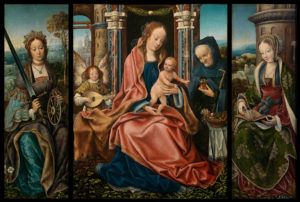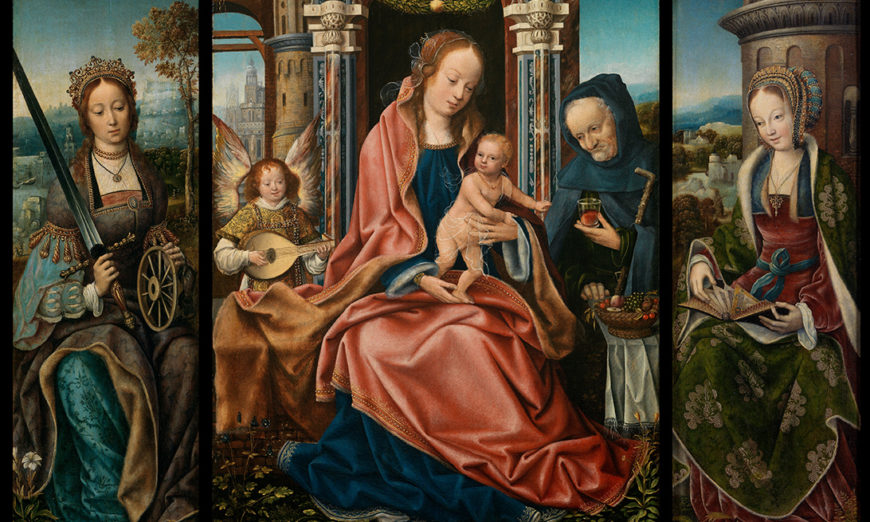I was recently teaching a seminar on macro photography and I asked the attendees what they associated with macro photography and unsurprisingly the top answer was “flowers”.
Now I’ve got nothing against images of flowers, I make them myself. However, a flower is a very challenging image because flowers are naturally beautiful. A photo of a flower that shows a beautiful flower is lovely but not really compelling. We have to make something more out of beautiful subjects.
I’ve been very fortunate to present to and to act as a photo judge for a number of garden and horticultural clubs. I’m always impressed by these folks because they see so much more than just the flower. I know little of botany or horticulture, but I do understand the importance of story, or at minimum the delivery of the framework for a story.

I also like to photograph religious iconography when I travel. One of the very effective methods used by classical artists is called a triptych. It’s a story in three paintings. In many situations, the triptych would front an altar or other holy spot. These two topics, flowers and triptychs have given me the idea for a spring assignment that leverages both. So, here we go.
If flowers are naturally beautiful, we need to push that farther to make a compelling story. Your mission, should you decide to accept it, is to challenge yourself to make a floral triptych. How you build it is your business but here’s a workflow to consider.
Find a flower or plant that you want to be the star of your story. In the first frame, you might consider to show it in its starting state. For most of us, this could be in a tray at a garden centre. Maybe you grow your own from seeds, whatever works.
Build an image that conveys the idea of the origin. Feel free to crop and edit it as you see fit. Make the image capable of standing alone, but don’t forget that it’s also page one of your three-page story.
Your second image is going to need some creativity. In this image, you want to show the flower’s transition from its origin to where it will end up. If we continue with our example workflow, you might be inclined to make an image of the flower in its little pot lying on the ground beside a trowel and a hole you’ve dug to plant it in. Again feel free to edit the image so it stands on its own but also tells the second page of your story.
Your final image might be the flower planted in its hole, perhaps freshly watered and with water beading on it. Maybe the little identifying tag is stuck in the ground beside it. Edit the image as needed to make it stand alone and to be the final page of your story.
Now that you have your three images, you’re going to want to make a composite image. One really popular way to do this is to use a 3 Up template in Lightroom’s print module but there are many ways to do this. Your goal is to lay out your three images on a single “page” so your story can be read left to right. Many applications offer this kind of templated layout. One that I like places three images vertically on an 8×10 final sized page. The individual images are along the size lineup of 2 ¼ x 6 ½ inches each, so they are cropped in on the sides to focus attention. The three images are placed equally on the page. Some templates also offer some “frames” that go around the individual images. There are many options to choose from when you start looking.
I usually include images in my articles, but this time I haven’t because I want to encourage you to envision your own success, not base it on my own poor example.
Once you’ve made your floral triptych don’t stop there. When you start doing your own research you will find many different ways of using a 3 Up layout to tell a story. Sometimes the artist will break a single image into three parts and lay them out as a triptych. With the increasing simplicity of making panoramas, this has become very popular in recent times. Other artists use the triptych to tell the story of a person from baby photo to childhood to adulthood. This idea of a story in three parts is really compelling and very effective. I wish you success in making your own.
Until next time, peace.
Ross Chevalier




COMMENTS (3)
Al Hughes
()
Ross, I’m an amateur photographer and as such, I would like to try your triptych challenge. Where would I submit the results when finished?
Henry's
()
Thanks for your interest and commitment to your own success in the spring challenge. If you would like a personal critique of your amazing work, feel free to send a JPEG image along to ross@thephotovideoguy.ca. Please keep the image size not larger than 2mb. You will receive your personal response within a couple of days. One image per person please.
Dansudbury
()
Ross, thank you again for this GREAT information. You sure have a way to makes everything look fun and easy to do…! I sure will try this triptych…. An excellent way to practice story telling shots!!! Have a GREAT day! God bless you ♫